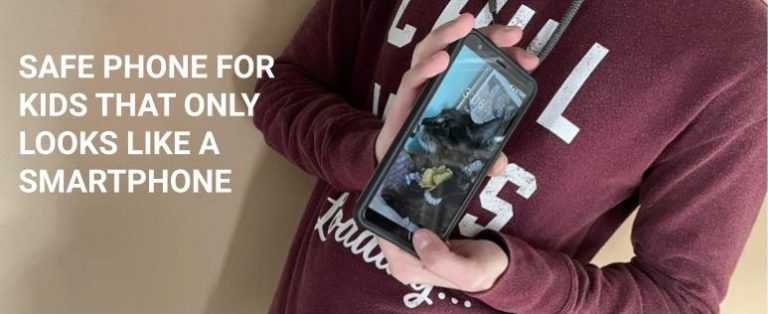My Kids Have No Smartphones and They Are Ok
Neighbors stop me on the street to comment how unusual it is that my children say hello, look them in the eye, and engage in a friendly chat. “Kids just don’t do this anymore!” – they exclaim. I think I know why my neighbors are so pleasantly surprised.
My kids have no smartphones.
With their mom hyper-informed about the dangers of addictive tech they never had any.
Yet, we wanted to give our kids the means of reliable communication, and the ability to arrange their own social life. What did we want in their phones?
Only these:
- Communication
- Safety
- Independence
Unfortunately, what actually happens with a regular smartphone is nothing less than an assault on kids’ humanity. Distraction, toxic social media, addictive video gaming, and porn – to name just a few.
So, we experimented with various flip phones through the years, with mixed results.
You see, flip phones were just NOT COOL for my kids. Socially embarrassing to use around their friends. Who wants to be made fun of and teased about their strict parents? Teenagers want to blend in with the smartphone crowd – not stand out!
Besides, flip phones operating on an old GSM standard had connectivity issues – they would randomly disconnect from the network and stop working altogether. Bummer.
Another option was to disable features and install parental controls on a regular smartphone. But we quickly ruled it out for one simple reason: these can and will be hacked. Believe me, I know. I receive messages from kids all the time along the lines:
“You parents are so dumb thinking we cannot hack your parental controls!”
Let’s face it, kids are just smarter than us, the tech dinosaurs. Addictive tech designers made sure they are motivated to find a way around our screen time restrictions.
What we needed was a phone that only looked like a smartphone. A phone without the need for parental controls. A phone that allows communication without addiction, so children limit their own screen time. That’s how we decided to get kid-safe Gabb phones for 2 of our older children – boy, 15, in high school, and girl, 12, in middle school.
This is their day-to-day experience of living with a “non-smart” phone.
Boy, Age 15

Girl, Age 12

As soon as she got her Gabb phone, my daughter customized her home screen with the picture of our cat and special icons to text with Mom and her best friend. Then she proceeded to cover the back of the phone with cat stickers. 🙂
Within the first day of using the phone she arranged a sleepover with a friend and a hangout with classmates at a local festival. “I like organizing my social life!” Took more pictures of cats to add to her phone gallery. Sent pictures of her artwork to her art teacher, and received glowing praise in return.
Today, she regularly does homework with her best friend over the phone. Not like other kids do on the apps – sharing screenshots of completed work to cheat on their assignments. No, she gets onto good old-fashioned long phone call with her friend and they work through math problems together. I hear them encouraging each other to keep pushing through difficulties, to fight procrastination, to imagine how good it would feel to get an A! My daughter informed me that she is considered a “good influence” by her friends’ parents.
They are talking on the phone like girls used to do in ages past. They take pictures of their pets to send to each other. Our cat’s picture goes to a few selected friends as an MMS message – not broadcasted to the whole world via social media. My daughter knows the importance of not putting pictures on the Internet to guard her privacy and reputation. Or that of our cat. 🙂
She texts friends. She calls grandma. She is talking to people, not algorithms. She complains about kids on her school bus – when she wants to socialize, they are on their phones. “It is so frustrating to be ignored!”
If I give my girl a smartphone now, she would be peer-pressured to use the same apps everyone is using and would risk getting sucked into the dangerous world of social media. At the time when her school counselor is overloaded with risk assessments for middle school girls. At the time when girls her age land in a mental hospital. I dare not open Instagram’s can of worms.
Even with kid-safe Gabb phones, I still insist that my children put their phones in their charging location downstairs for the night. I do not want their sleep to be disrupted by messages from their friends. No tech in the bedroom is the habit I want them to have for life, because when they eventually do get a smartphone, to be able to separate from it is an essential wellbeing skill.
Mom, Middle Age 🙂
To begin with, Gabb phones allowed me to give my children the expansion of their social lives. Without the downsides that usually come with a smartphone – compulsive use, distraction from academic work, and exposure to darkness online. I long waited for my kids to arrange their own “hangouts” with friends (after a certain age you cannot call it “playdates”!). But without the phone they would willingly use it was not happening. I was stuck as the one in charge of texting their friends’ parents for all the details of where and when they should meet – like they were still toddlers. It took a big chunk of my time, it was exhausting, and more than a little embarrassing.
Like a mini-version of “failure to launch”.
Now they use their phones to arrange meeting friends in person. The phone does not have the option for Discord (online gaming) gatherings, or Snapchat, or Instagram, or any of the multitude of online platforms where kids these days pretend to “socialize” while sitting in solitary confinement in their rooms.
And when my kids are out of the house for their social engagements, their phones have GPS tracking to alleviate my parental anxiety! I have installed the app on my smartphone and paired it with my kids phones. Now I see in real time that my kids are in the school building where they are supposed to be. I see that my son is at his track practice, and my daughter is at the library. I can see where they are biking in the neighborhood – or camping with daddy on the other side of the state. I love the assurance of always knowing where my kids are.
What I also love is that advertisers, online predators, or toxic classmates cannot use my kids’ location to harm or manipulate them.
How do they keep in touch with their friends who only use apps like Snapchat for communication? Well, they don’t. Unless the communication happens in person or via regular text or phone call, it is not happening at all. Do my kids miss out? Yes, they do.
- If there is a party they have not been invited to, they have no clue
- If there is a nasty piece of gossip circulating about them, they are oblivious
- If there is drama, they are not part of it.
I kind of like it this way.
The opposite of FOMO (Fear of Missing Out) is JOMO (Joy of Missing Out).
When my kids come home from school, they seem peaceful, not anxious. They unpack, have a snack while reading a book, and start their homework. They need time to relax and decompress after a long school day.
Their ignorance of 24/7 social media frenzy is their bliss – and mine.
Real Life as the Most Interesting Thing
I want to make another important point. When I track my kids’ location, I can see where they are but not what they are doing.
However, I can assume they do not stare at their phones.
I do not have to worry if they pay attention to the teacher at school, coach at sports practice, or their friends at lunch. I know they are – because there is no better option! There is not much to do on a Gabb phone unless they need to reach a real person. No games. No social media. No Internet. I suppose they could play with a calendar or the calculator, but these are not particularly entertaining.
By default, real life right in front of them becomes the most interesting thing.
That’s the magic of crafting their environment to prevent bad digital habits from taking hold. Smartphones are the most engaging, addictive drug in the hands of our children. Remove the smartphone – and they start paying attention to other things. Change their habitat – and you change their life. Setting them up for success in academics, sports, and relationships.
No doubt, my kids miss out on a lot of good things happening online. That’s the price we are willing to pay as a family.
- They are not connected to their peers 24/7 – but they are not expected to reply instantly to messages.
- They miss out on connecting with peers via social media – but they are comfortable communicating to kids and adults face to face.
- When no people are around, they are comfortable being alone with their own thoughts and books.
- They post nothing so they get no validation online – but no one can use their opinions against them either. Trolls cannot hurt them.
As parents, we focus on the dangers of smartphones, but often overlook the DISPLACEMENT of healthy human activities by digital media. All the things kids could be doing if they were not on their phones.
What our family tries to do is create this space in our children’s lives. To create a void – so that kids could fill it with something other than screen time. I step aside and observe how my kids fill their free time without smartphones or other tech in the picture. They read. They play. They fight with each other. Healthy boredom really does work. In the evenings they get their screen time. There is balance between screens and real life.
I think it’s unfair to expect children to resist smartphones. Wait Until 8th campaign encourages parents to sign a pledge of waiting until at least 8th grade before giving a child a smartphone. I signed it. With the way things are in the digital space lately, I think we might wait until 18.
A natural speed bump on the way to smartphone ownership we are currently debating is to make kids buy their first smartphone with their own money. To be able to earn and save assumes a certain level of maturity – and responsible use of technology. At least that’s our hope.
Are my kids resentful that they do not have smartphones? A little. But they have accepted the fact that smartphone ownership would happen for them at a much later age than their peers.
Of course, like all of their friends, they would rather have the phone. They believe they would be able to handle it. But still we wait. Like in the movie “Braveheart” we shout “Hold!” to postpone the inevitable battle. Addictive technology is powerful – we want to give our children time to get stronger.
Yes, they roll their eyes when their parents explain the dangers of smartphones to their mental health, academic performance, and reputation – again and again. As Chris McKenna of Protect Young Eyes said in the Childhood 2.0 documentary: “If you are not talking about Internet safety to your kids until you are at least a little annoying, you are not doing it enough”.
My kids assure me I am annoying enough. 🙂





